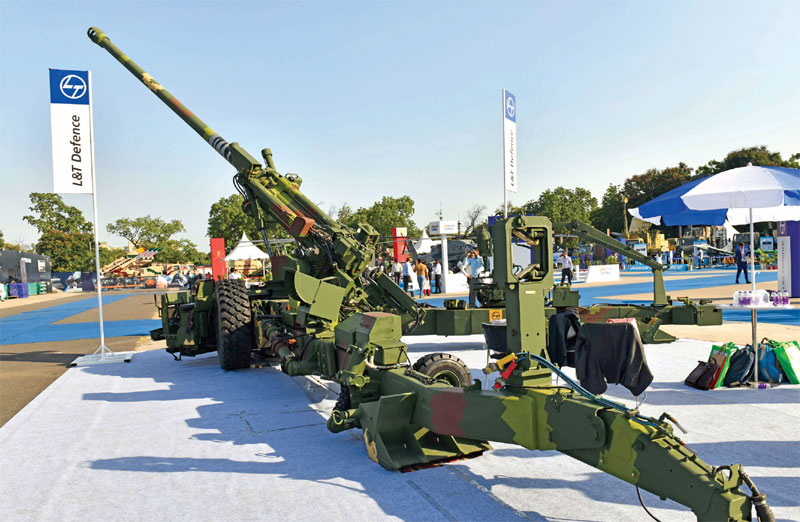Need better balance between revenue and capital budget for defence modernisation, given the threat from China
 Lt Gen. Zameeruddin Shah (retd)
Lt Gen. Zameeruddin Shah (retd)
India’s defence spending is dependent on the threat perceptions and imperatives of maintaining battle ready armed forces to meet all possible contingencies. The restraining factor is the state of the economy, its resilience and its long-term sustainability. Political decisions have to be made to divert scarce financial resources from areas which impact the common citizen. This is an onerous task. A realistic balance has to be maintained. Enhancing budgetary allocations is an imperative to cater to modernisation and for defence R&D to keep abreast with rapid advancement of technology, especially in the fields of aerospace, submarine, UAV, cyber and artificial intelligence. The high rate of obsolesce of weapon systems and their replacement makes this an imperative.
For the uninitiated in defence finances, the outlay of defence budget is under two major heads—revenue and capital. The capital expenditure is utilized for modernisation and procurement of arms, ammunition, weapons as well as for creation of defence infrastructure. Expenditure under the revenue head comprises military pay and allowances, including those of civil defence employees. High revenue expenditure leaves little for capital acquisitions.
Due to financial constraints, the yearly budget increments cater only for inflation. This suffices for revenue expenditure but is totally inadequate for capital expenditure where incremental change cannot be applied. There has been a quantum jump in technological advancement and the rate of obsolesce is high. Replacements are costly. Financial constraints preclude the defence forces from holding 100 per cent modern weapons and equipment at any given point of time. Even modern armies cannot achieve this. A realistic situation is having a mix of 50 per cent state of the art, 30 per cent obsolescent and 20 per cent obsolete (but under upgradation/replacement) systems.
A comparison of defence expenditure of India with its adversarial neighbours should indicate the pressing requirement for increase in defence spending. India’s defence expenditure of USD 70.2 billion is one third that of China’s USD 237 billion in the current financial year. It should not provide any consolation that Pakistan, on the verge of financial collapse, could allocate only USD 11.3 billion and is under increasing pressure to further cut down its defence budget by International Monetary Fund.

Resource Constraints
The ministry of defence (MoD) has been battling resource constraints for several years. In the last six years, the MoD’s annual shortfalls have consistently remained over Rs 100 billion, or approximately 17-23 per cent. The additional amount, provided in the new budget, is inadequate to meet the short falls of the preceding budgets.
This amount is around 13.33 per cent of total government expenditure and just 2.04 per cent of the estimated GDP. Capital expenditure, for modernisation, is not keeping pace with that of our adversaries. The gap with China is large and the chasm is growing wider. There is thus a requirement for a bigger hike in defence budget allocation, coupled with reduction in revenue expenditure.
In this era of technological advancement, the rate of obsolesce is fast, necessitating periodic and frequent change/upgrade every 10/20 years, unlike earlier years where it extended to longer than half a century. Costs for replacement are phenomenal. For example, India’s field artillery depended largely on the 25 pounder guns of pre-World War II vintage until recently. These guns, with a range of only 12,250m were extensively used in the 1971 Indo-Pak war. My regiment used them during the Battle of Longewala in 1971 and it was a herculean task to physically drag them across the desert terrain. The process for replacement of these guns had commenced, post 1965, with imported Russian 100mm field guns and indigenous 75/24 howitzers. They could only be totally replaced in 2023 when the gun salute during Republic Day parade was fired by 105mm Indian field guns.
When I got my commission in 1968, we had been trained on the Lee Enfield .303/ 7.62 bolt action rifles, introduced in 1904. Replacement for the same was necessitated after our .303 bolt action rifles were no match for Chinese automatic weapons in 1962. There was also a requirement to discard our cumbersome World War I vintage web equipment, hob nailed boots and tin hat helmets. Now a soldier has to be equipped with a modern light weight automatic rifle with night vision/ firing capabilities, bullet proof jacket, hand-held thermal devices and helmet mounted sensors.
Defence spending and economy
The health of the economy dictates the quantum of funds which can be allocated for defence. It is assessed that the Indian economy is likely to grow at 7.0 per cent in the current fiscal year and subsequently maintain the rate of 6.0 to 6.8 per cent in 2023-24, with a baseline GDP growth of 6.5 per cent. If achieved, it would make India the fastest growing economy in the world. Does this portend well for the defence budget, especially in a scenario where there are growing external threats?
Defence expenditure by India has been showing a rising trend at an average of 8-10 per cent per annum in the last decade. The defence expenditure, under all heads, was around USD 47.22 billion in 2013-14, approximately 1.79 per cent of the GDP and 12.23 per cent of total government expenditure. In the current financial year (2023-24) the expenditure has climbed up to USD 72.4 billion (INR 5,935.38 billion) and represents a 13 per cent increase over the previous year’s allocations. This is 1.5 per cent of the GDP and inadequate.

Various Stakeholders
The 2023-24 budget follows the pattern of previous allocations with the army receiving the largest share though it continues to be the least capital-intensive service, with 83 per cent of its total allocation utilised for revenue expenditure. The upward revision of the non-salary revenue expenditure was driven by the exigencies created by the ongoing crisis in Ladakh and Arunachal Pradesh. This necessitated a significant increase in the capital expenditure on the Border Roads Organisation (BRO) in order to match Chinese infrastructure efforts in Tibet and across the line of actual control (LAC). Strategically important assets such as the Sela Tunnel, Nechipu Tunnel and Sela Chhabrela Tunnel were necessary to enhance border connectivity and for operational flexibility. The BRO’s budget, which was pegged at Rs 35 billion in 2022-23, was revised to Rs 45 billion and to Rs 50 billion in the present budget.
The navy’s allocation saw an all-time high increase of 20 per cent. The increasing share of the navy is an indication of India’s changing threat perceptions, from exclusively continental to maritime, primarily because of Chinese naval presence in the Indian Ocean. China has been increasing its footprint with India’s neighbours—Nepal Sri Lanka and Pakistan—and is now posing a direct challenge to New Delhi’s influence in South Asia.
The air force received 14 per cent. The Defence Research and Development Organisation (DRDO) and the Ordnance Factories (OFs), which the government has converted into seven corporate entities, have seen a decline in their shares in the budget.
Increasing Defence Spending
Considerable efforts have been made over the years to decrease revenue expenditure to enable more resources for capital acquisitions. Considering the average rate of inflation of around seven per cent during the last few years, as well as the growing need for maintenance of existing assets, gradual replacement of older and phasing out of equipment and to match the need for continuous modernisation, the enhanced budget allocation to the MoD has been far below the requirement of the armed forces.
Within the revenue expenditure, the stores budget of the three forces utilises 32 per cent to the MoD’s overall budget increase, followed by pension, 27 per cent, and pay & allowances of the armed forces (including the Agnipath scheme) 7 per cent. The payment of OROP and the border deployments have been the main reasons for the MoD’s latest budget increase.
MoD (civil), defence pensions and defence services consumed the major slice of upward revision of revenue expenditure due to large hikes in pensionary benefits and non-salary revenue expenditure. The mid-year hike in the pension allocation and OROP scheme, necessitated by judicial rulings, account for 57 per cent (Rs 337.18 billion) of the MoD’s total budget increase, leading to an additional allocation of Rs 281.38 billion. The has led to a noticeable jump in the MoD’s revised budget of 23 per cent. It would have been higher had it not been for only marginal increase in pay and allowances of the armed forces by only three per cent from Rs 1,494 billion to Rs 1,545 billion. This marginal increase is largely due to depletion of the armed forces strength, caused by the pandemic-induced restrictions on recruitment, and the Agnipath scheme. Army veterans in unanimity have warned of the deleterious effects of the Agnipath scheme. Cutting costs must not imperil the security of the country.
The increase in the non-salary revenue expenditure of the armed forces was primarily to procure critical ammunition/ spares and cater for the repair and maintenance of existing equipment. The expenditure on ‘stores’ budget has been revised upward by 23 per cent during the mid-year review of the previous budget. It stands at Rs 592 billion in the present budget, primarily driven by the prolonged engagements against Chinese armed forces.

Cutting Revenue Expenditure
Manpower: We need a lean and mean armed forces. Army units have already been stripped to the bone in manpower and any further reduction will have a debilitating effect on battle efficiency. There is, however, a need to cut down on the pension bill, especially in the case of officers, the cadre strength of which is 65,000. This can be achieved by having 25 per cent regular officers and 75 per cent short service commissioned officers with a tenure of 10 years after which they should be automatically absorbed in Central Para Military Forces such as the Assam Rifles, BSF and the CRPF. There will be resistance from these forces, but it must be pushed home as it would considerably improve their operational performance. For troops, the Agniveer tenure of four years is far too short to have mature and well-trained soldiers. Their term of service should be extended to 10 years with 25 per cent being retained and the balance 75 per cent being automatically inducted into the paramilitary forces.
Civil employees in defence estimates: Their numbers need to be drastically reduced. Services like the MES can be outsourced. Although the salaries of these civilians are no more payable out of the defence budget, payment of their pension continues to be a drain on the defence budget. The category of civil defence employees should be delinked and merged with the DOPT and be placed under a fixed period of deputation to the MoD or their services should be outsourced, wherever feasible, without compromising on security. It is recommended that the pension of these categories should be delinked from the defence budget.
R&D: There is a need to provide impetus to R&D. The DRDO should, initially, concentrate on mastering reverse technology. IITs and engineering colleges should be given grants to carry out research in products which have both commercial and military application.
Indianisation: There is ample scope to achieve a higher contribution of at least up to 90 per cent Indianisation in the field of procurement and adopting advanced technology in the sub-branches of communication, UAV, transport, consumable ordnance and laser devices. In the armed forces medical services, Indianisation is below par despite the fact that India has achieved competence in equipment and medical devices that match that of developed countries.
Defence Industry: Greater incentive should be provided to domestic industry, particularly the private sector. In the previous budget, the finance minister promised a host of measures—e.g., earmarking 25 per cent of R&D budget for use by the industry; creation of an ‘independent nodal umbrella body’ to meet the testing and certification requirements of the industry; allocation of 68 per cent of capital procurement budget (up from 58 per cent in 2021-22) for procurement from the domestic industry; and creation of ‘Special Purpose Vehicle’ (SPV) to allow the industry to undertake design and development in partnership with the DRDO. These incentives should be implemented. The subdued growth in overall procurement budget gives few new contracts from which the domestic industry can benefit. The Indian industry is very much capable of defence production but is inhibited by the lengthy ‘validation’ and ‘trial procedures’. These should be shortened and made more transparent. Tax reforms in the form of rational liberalisation in GST and complete tax holiday for more than 10 years should be considered to spur industry to participate in defence production.
The new budget has made some provisions to enhance the participation of start-ups and micro, small and medium enterprises (MSMEs) to foster innovation, encourage technology development and strengthen the defence industrial ecosystem in the country. The allocations for Innovation for Defence Excellence (iDEX) and Defence Testing Infrastructure Scheme (DRIS) have been enhanced by 93 per cent and 95 per cent to Rs 1.16 billion and Rs 0.45 billion respectively. Though these amounts may be minuscule compared to the overall R&D budget (of the DRDO), the MoD nonetheless believes that they will help fulfil its “vision to leverage ideas from bright young minds across the country.”
Defence Corridors: The government must push for infrastructure development, better transportation, communication and uninterrupted power energy to the areas of defence corridor. There is a need to develop more defence corridors adjoining the western, northern and eastern India.

Strategic Partnerships
A budget that is high on revenue and low on capital does not augur well for India’s defence posture. The rise in India’s latest defence budget is not evenly distributed as most increases are driven by the revenue expenditure with capital expenditure contributing marginally to the overall growth. The revenue-driven growth, largely due to increases in the pensionary benefits and the exigencies at the borders with China, were unavoidable.
However, the mid-year decline in the MoD’s previous capital expenditure and a marginal increase in the new budget is a cause for concern given the acute shortages in budgets for the armed forces’ modernisation drive. It also reveals the limited scope of the defence budget to cater to unforeseen exigencies while retaining space for sustained modernisation of the forces.
To contest the growing gap with China, India must strengthen its security and strategic partnerships with like-minded countries, opposed to Chinese belligerence like Quad. It must extend tacit support to AUKUS and focus on building defence and security partnerships with countries in the Indo-Pacific. India’s strategy and preference must be to seek a coalition of partners to deter Chinese hegemony. While such coalitions are indeed helpful, it would nonetheless be in India’s interest to keep its defence spending at a higher growth path to narrow the disparity with China. India has to not only to increase its defence spending in a sustained manner but ensure that greater proportions of the additional allocations are devoted to the modernisation of the defence forces.

